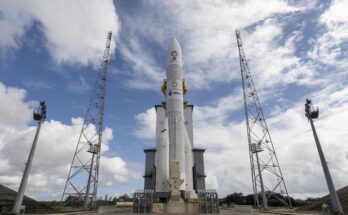by Bill Ostrove, Space Systems Analyst, Forecast International
The Indian Space Research Organization (ISRO) has successfully launched a reusable launch vehicle demonstrator, dubbed the RLV-TD. The RLV-TD is a delta-winged spacecraft designed to lift off vertically and land horizontally. Its reusability reduces launch costs.
The 6.5-meter-long, 1.7-metric-ton RLV-TD took off on May 23 at approximately 7:00 a.m. IST (1:30 a.m. UTC; May 22 at 9:30 p.m. EDT) from the Sriharikota launch center aboard a small booster rocket. The rocket carried the RLV-TD to 50 kilometers, where the orbiter separated and climbed another 20 kilometers under its own power. It then landed in the Bay of Bengal after reaching a speed of Mach 5. Even though the vehicle is designed to land on a runway, the prototype landed at sea and will not be recovered. Flight data was remotely sent to mission control.
The ISRO spent about INR95 crore ($14.3 million) and six years developing the prototype vehicle. It is five times smaller than the planned operational vehicle. The operational spacecraft will have two stages, and will be powered by both air-breathing and rocket engines. Once operational, the ISRO expects the vehicle to reduce launch costs by up to 10 times compared to current launch vehicles, such as the PSLV.
Reusable launch vehicles have become increasingly popular in recent years. At one time, NASA’s Space Shuttle was the preeminent reusable launch vehicle. However, cost savings never materialized, significantly reducing the attractiveness of the vehicle for both commercial and government passengers. It was eventually retired in 2011.
The Space Shuttle illustrates the problems with reusable launch vehicles. Redundancies needed to ensure mission success multiple times and refurbishing the spacecraft for each use can drive up costs, eventually making a reusable launch vehicle more expensive than an expendable one.
That said, the promise of reusable launch vehicles has never subsided. Private U.S.-based companies SpaceX and Blue Origin are both working to develop commercial reusable launch vehicles. Other countries remain interested as well. If the process of refurbishing the spacecraft can be made more efficient, the costs can be reduced significantly. With multiple organizations working to develop reusable vehicles, space travel could become much cheaper in the future.
Please feel free to use this content with Forecast International and analyst attributions, along with a link to the article. Contact Ray Peterson at +1 (203) 426-0800 or via email at ray.peterson@forecast1.com for additional analysis.
Sources:
Forecast International offers two Space Systems Forecast products: Launch Vehicles & Manned Platforms, with reports on manned spacecraft, expendable launch vehicles and more, and Satellites & Spacecraft, with coverage ranging from microsatellites to large COMSATs – all complete with technical specifications and forecast details. 
A military history enthusiast, Richard began at Forecast International as editor of the World Weapons Weekly newsletter. As the Internet grew in importance as a research tool, he helped design the company's Forecast Intelligence Center and currently coordinates the EMarket Alert newsletters for clients. Richard also manages social media efforts, including two new blogs: Defense & Security Monitor, covering defense systems and international issues, and Flight Plan, which focuses on commercial aviation and space systems. For over 30 years, Richard has authored the Defense & Aerospace Companies, Volume I (North America) and Volume II (International) services. The two books provide detailed data on major aerospace and defense contractors. He also edits the International Contractors service, a database that tracks all the contractors involved in the programs covered in the FI library. More recently he was appointed Manager, Information Services Group (ISG), a new unit that encompasses developing outbound content for both Forecast International and Military Periscope.



